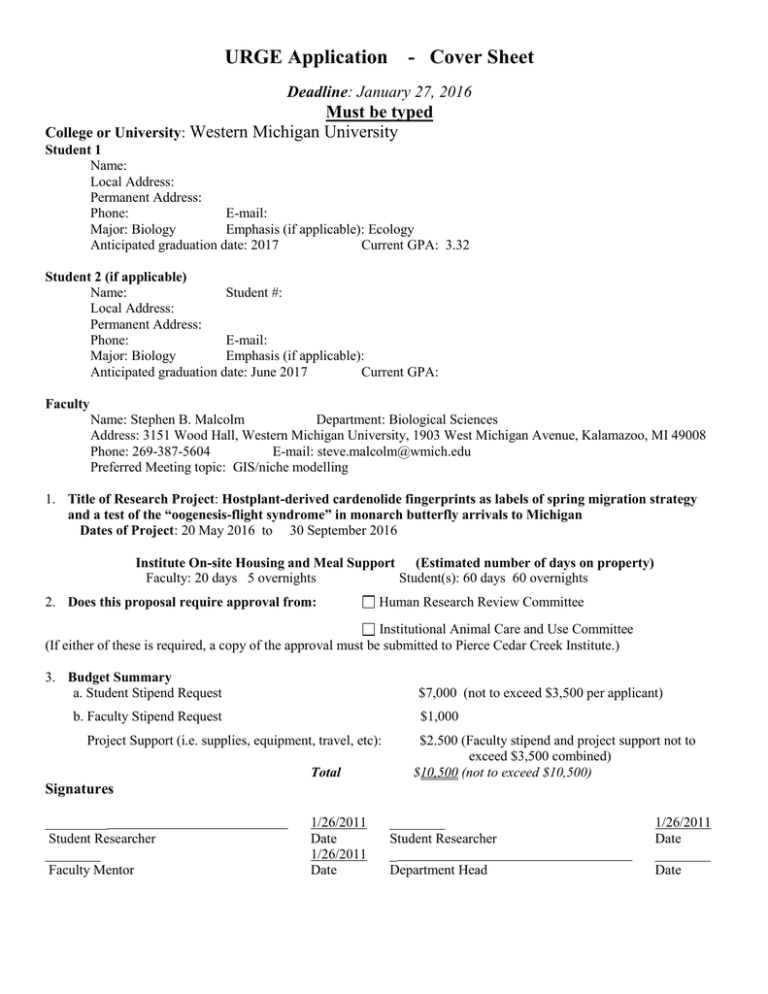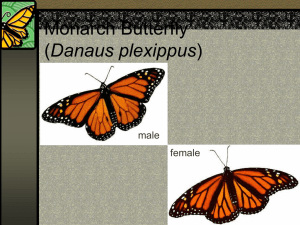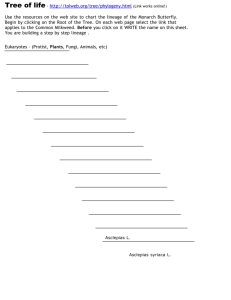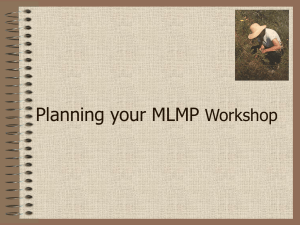URGE Application - Cover Sheet Deadline
advertisement

URGE Application - Cover Sheet Deadline: January 27, 2016 Must be typed College or University: Western Michigan University Student 1 Name: Local Address: Permanent Address: Phone: E-mail: Major: Biology Emphasis (if applicable): Ecology Anticipated graduation date: 2017 Current GPA: 3.32 Student 2 (if applicable) Name: Student #: Local Address: Permanent Address: Phone: E-mail: Major: Biology Emphasis (if applicable): Anticipated graduation date: June 2017 Current GPA: Faculty Name: Stephen B. Malcolm Department: Biological Sciences Address: 3151 Wood Hall, Western Michigan University, 1903 West Michigan Avenue, Kalamazoo, MI 49008 Phone: 269-387-5604 E-mail: steve.malcolm@wmich.edu Preferred Meeting topic: GIS/niche modelling 1. Title of Research Project: Hostplant-derived cardenolide fingerprints as labels of spring migration strategy and a test of the “oogenesis-flight syndrome” in monarch butterfly arrivals to Michigan Dates of Project: 20 May 2016 to 30 September 2016 Institute On-site Housing and Meal Support (Estimated number of days on property) Faculty: 20 days 5 overnights Student(s): 60 days 60 overnights 2. Does this proposal require approval from: Human Research Review Committee Institutional Animal Care and Use Committee (If either of these is required, a copy of the approval must be submitted to Pierce Cedar Creek Institute.) 3. Budget Summary a. Student Stipend Request $7,000 (not to exceed $3,500 per applicant) b. Faculty Stipend Request $1,000 Project Support (i.e. supplies, equipment, travel, etc): Total $2.500 (Faculty stipend and project support not to exceed $3,500 combined) $10,500 (not to exceed $10,500) Signatures _________ Student Researcher ________ Faculty Mentor 1/26/2011 Date 1/26/2011 Date ________ Student Researcher _ Department Head 1/26/2011 Date ________ Date URGE Application 1. Proposal: Hostplant-derived cardenolide fingerprints as labels of spring migration strategy and a test of the “oogenesis-flight syndrome” in monarch butterfly arrivals to Michigan. a. Synopsis: We propose to determine whether the first monarch butterrfly arrivals to Michigan have flown from Mexican overwintering locations, or are the offspring of these butterflies that have flown from the southern USA. We will use a chemical fingerprinting technique to discriminate between “single sweep” migration and “successive brood” migration and determine how synchrony of monarch population density in southwest Michigan changes with time over the summer. We will also collect data to determine whether monarch females either migrate without eggs as predicted by the “oogenesis-flight” syndrome or simultaneously migrate and carry eggs ready for oviposition on milkweed larval host plants. While much is known about monarch migration, reproductive behavior, hostplant use and defense against natural enemies, we know little about the most important phase of monarch life history when most population increase is thought to occur on the common milkweed, Asclepias syriaca, in the Great Lakes region. b. Introduction: The monarch butterfly, Danaus plexippus, is an iconic example of insect migration by virtue of its predictable, long-distance annual migration in North America between overwintering locations in Mexico and breeding habitat distributed across the USA and southern Canada east of the Rocky Mountains (Figure 1; Urquhart, 1960; Johnson, 1969; Urquhart and Urquhart, 1976, 1978; Baker, 1978; Brower, 1985; Calvert and Brower, 1986; Malcolm, 1987; Brower and Malcolm, 1991; Brower, 1995, 1996). From early wing-tagging studies by Nora and Fred Urquhart in Canada (Urquhart, 1960; Urquhart and Urquhart, 1976, 1978) and later studies coordinated by Orley Taylor of Monarch Watch at the University of Kansas (http://www.monarchwatch.org/index.html) we know that adult monarchs fly each autumn to 12 locations in oyamel fir forests above 3,000 m altitude in the Sierra Transvolcanica mountains of central Mexico, west of Mexico City (Calvert and Brower, 1986; Brower, 1985, 1995, 1996). There the butterflies remain for up to 5 months over winter in tightly aggregated clusters until their return migration north in spring at the end of March. We also know that the same butterflies that left the USA and southern Canada in the autumn, and spent the winter in Mexico, return to the southern USA where they mate, lay eggs and die (Cockrell et al., 1993; Malcolm et al., 1993). The offspring of these migrants Rowe, Stevens & Malcolm (WMU) Monarch butterfly migration page 2 from Mexico then feed on southern hostplant species and upon emergence as adults continue the migration north to recolonize the full spatial extent of their milkweed hostplants across North America, east of the Rocky Mountains (http://www.learner.org/jnorth/monarch/index.html). Figure 1. Distributions of monarch butterfly overwintering locations in Mexico (A) and 4 common milkweed larval hostplants (Asclepias spp.) in North America east of the Rocky Mountains (Malcolm et al., 1993), with a photograph of 2 adult monarchs basking on leaves at the Sierra Chincua overwintering location near Angangueo, Michoacán, Mexico (photograph by L.P. Brower). In addition to their spectacular annual migration in North America, monarch butterflies are well known for their specialized larval feeding on milkweeds in the genus Asclepias and their ability to sequester toxic steroids known as cardenolides for use in defense against natural enemies such as birds (Brower et al., 1967, 1968, 1972; Brower, 1969; Brower and Moffitt, 1974; Fink and Brower, 1981; Malcolm and Brower, 1989; Glendinning and Brower, 1990; Malcolm, 1990; Alonso-Mejia and Brower, 1994; Malcolm, 1995). Interestingly, each Asclepias hostplant species generates a different pattern of sequestered cardenolides in adult monarchs (Figure 2) and Malcolm et al. (1993) used these chemical “fingerprints” as indicators of migratory strategy in spring migrants. Malcolm et al., hypothesized that monarchs either migrate using a “single sweep” strategy or a “successive brood” strategy (Figure 3). In “single sweep” migration the entire breeding distribution of monarchs would be accessed by overwintered migrants that move north and lay eggs as they progress through both space and time. In “successive brood” migration the migrating spring butterflies would reach the southern USA from Mexico, mate, lay their eggs on southern Asclepias species (Figure 1) and die, Rowe, Stevens & Malcolm (WMU) Monarch butterfly migration page 3 leaving their offspring to continue the migration north. Evidence from cardenolide fingerprints and wing wear patterns (Malcolm et al., 1993) as well as isotopic signatures (Wassenaar and Hobson, 1998; Hobson et al., 1999) show that spring migration does occur via successive broods. Figure 2. Cardenolide fingerprints in monarch adults from 4 Figure 3. Hypothesized spring Asclepias host plant species separated on a thin layer migration strategies for monarch butterflies that recolonize North chromatogram (Malcolm et al., 1993). American m ilkweed breeding habitat east of the Rocky Mountains (Malcolm et al., 1993). While much is known about migration, mating behavior and physiology, hostplant use and the operation of defense against natural enemies in monarch butterflies, we still know little about the dominant phase of their life history when their annual populations increase during the summer or about how monarchs both migrate and lay eggs. Michigan is in the center of the extensive distribution of the common milkweed, Asclepias syriaca, which is the most important hostplant for monarchs (Seiber et al., 1986; Malcolm et al., 1989) out of the 108 species of Asclepias milkweeds known from North America (Woodson, 1954) and it is in their northern range that monarchs generate up to three successive generations (Borkin, 1982; Malcolm et al., 1987), to establish the large numbers of butterflies that fly to Mexico each autumn. Migrating insects are thought to show a distinct trade-off between flight and reproduction so that migrating individuals are in reproductive diapause and reproductive individuals do not migrate. This trade-off is known as the “oogenesis-flight syndrome” and is argued to occur in monarchs (Johnson, 1969; Dingle, 1971; Barker and Herman, 1976; Herman and Barker, 1977; Baker, 1978; Herman, 1985; Rankin, 1985; Rankin et al., 1986; Rankin and Burchsted, 1992) . However, like Thomas and Showers (1992) we suspect that this is not the case for migratory monarchs and we have some evidence from prior work that migrating female monarchs lay eggs and that they carry chorionated eggs. Here we propose to research monarch breeding ecology during the summer throughout southwest Michigan in Rowe, Stevens & Malcolm (WMU) Monarch butterfly migration page 4 order to determine (1) the changing nature of spatial and temporal synchrony of monarch generations through the summer as measured by changing frequencies in host plant-derived chemical fingerprints, and (2) the relationship between generation synchrony and female monarch egg counts as a test of the “oogenesis-flight syndrome.” Thus we propose the following null hypotheses and their associated alternate hypotheses: Null hypothesis 1: Hostplant-derived cardenolide fingerprints of adult monarchs and their deposited eggs in Michigan are distributed randomly. Alternate hypothesis 1a: First arrival adult monarchs in Michigan show the Asclepias viridis fingerprint consistent with the “successive brood” migration hypothesis. Alternate hypothesis 1b: First arrival adult monarchs in Michigan show the Asclepias syriaca fingerprint consistent with the “single sweep” migration hypothesis. Alternate hypothesis 1c: As summer progresses in Michigan adult monarchs are increasingly derived from Asclepias syriaca until all autumn migrants are derived from that hostplant species. Null hypothesis 2: Field-caught monarch females show random distributions of chorionated eggs in their ovaries. Alternate hypothesis 2a: First arrival monarchs in Michigan have significantly few or no chorionated eggs in the ovaries consistent with the “oogenesis-flight syndrome.” Alternate hypothesis 2b: First arrival monarchs in Michigan have significantly more chorionated eggs in the ovaries than predicted by the “oogenesis-flight syndrome.” Alternate hypothesis 2c: As time progresses through the summer the numbers of chorionated eggs increase in the ovaries of female monarchs until the onset of hormonally triggered reproductive diapause. c. Methods: 1. Logan Rowe and Joel Stevens will search throughout southwest Michigan for monarch adults, eggs and larvae from late May through to early September in a variety of habitats. 2. Logan Rowe will use methanol extraction of adult butterflies and field-collected eggs to measure cardenolide fingerprints by high performance liquid chromatography and comparison of these fingerprints with monarchs fed as larvae on Asclepias syriaca and A. viridis as well as their eggs to determine the HPLC cardenolide fingerprints in adults and eggs. HPLC Procedure Rowe, Stevens & Malcolm (WMU) Monarch butterfly migration page 5 Sample analyses will be performed using the method of Wiegrebe and Wichtl (1993) on a Waters gradient HPLC system with WISP autosampler, 600E pump, 996 diode array detector and Millennium 2010™ chromatography software. The reverse-phase elution gradient is acetonitrile:water at 1.2 ml·min-1 at 40˚C, with 20% acetonitrile at start, 32% after 35 min., 40% after 45 min., 50% after 55 min., then back to 20% at 61 min., and 20% at 65 min., on a 250-4 LiChroCART® RP-18 column packed with LiChrospher® 100, 5µm (E. Merck) with a 10 mm guard column. 20 µl sample injections will be separated for 65 minutes and cardenolides detected at 218.5 nm and identified by their symmetrical spectra between 205 and 235 nm and a λmax of between 214 and 224 nm. Cardenolide concentration for each peak (µg/0.1g sample DW) was calculated from a calibration curve with the external cardenolide standard digitoxin (Sigma, St Louis, Missouri). Only cardenolide peaks reported by Millennium 2010® software as consistently pure are considered for analysis. 3. Mating experiments in flight cages at PCCI by Logan Rowe and Joel Stevens to determine male contribution to female and egg cardenolides in experimentally reared monarchs in order to determine male influences on cardenolide fingerprints.. 4. Analysis of the dissected bursa copulatrix in wild females by Logan and Joel for cardenolide content. 5. Using HPLC by Logan Rowe to fingerprint the hostplant-derived cardenolides in wild-collected adults and eggs. 6. Dissection of wild females by Joel Stevens to count chorionated eggs and analyze the bursa copulatrix for male contributions to the cardenolide profile. 7. Digital measurement of wing scale loss by Logan and Joel at the Biological Imaging Center at WMU. 8. Niche modeling by Logan and Joel of monarch butterfly voltinism using CLIMEX software and temperature records at PCCI and other weather stations in SW Michigan to predict monarch generations and compare predictions with reality based on immatures and adults sampled in the field (after Zalucki, 1981, 1982, 1983, 1985). d. Research conduct: Milkweeds are potentially toxic plants because they produce copious latex and their cardenolides target the Na+, K+-ATPase enzymes of potential consumers, including humans (Malcolm, 1995). Thus care will be taken when handling plants and insects by wearing disposable gloves. Care will also be taken in the laboratory handling solvents and glassware. e. References: Alonso-Mejia, A., and Brower, L. P. 1994. From model to mimic: age-dependent unpalatability in monarch butterflies. Experientia 50:176-181. Rowe, Stevens & Malcolm (WMU) Monarch butterfly migration page 6 Baker, R. R. 1978. The Evolutionary Ecology of Animal Migration. New York: Holmes and Meier. Barker, J. F., and Herman, W. S. 1976. Effect of photoperiod and temperature on reproduction of the monarch butterfly, Danaus plexippus. Journal of Insect Physiology 22:1565-1568. Beall, G. 1946. Seasonal variation in sex proportion and wing length in the migrant butterfly, Danaus plexippus L. (Lep. Danaidae). Transactions of the Royal Entomological Society of London 97:337-353. Beall, G., and Williams, C. B. 1945. Geographical variation in the wing length of Danaus plexippus (Lep. Rhopalocera). Proceedings of the Royal Entomological Society of London 20:65-76. Boggs, C. L., and Gilbert, L. E. 1979. Male contribution to egg production in butterflies: evidence for transfer of nutrients at mating. Science 206:83-84. Borkin, S. S. 1982. Notes on shifting distribution patterns and survival of immature Danaus plexippus (Lepidoptera: Danaidae) on the food plant Asclepias syriaca. Great Lakes Entomologist 15:199-206. Brower, L. P. 1969. Ecological chemistry. Scientific American 220:22-29. Brower, L. P. 1985. New perspectives on the migration biology of the monarch butterfly, Danaus plexippus L. Contributions in Marine Science Supplement 27:748-785. Brower, L. P. 1995. Understanding and misunderstanding the migration of the monarch butterfly (Nymphalidae) in North America: 1857-1995. Journal of the Lepidopterists' Society 49:304-385. Brower, L. P. 1996. Monarch butterfly orientation: missing pieces of a magnificent puzzle. Journal of Experimental Biology 199:93-103. Brower, L. P., and Brower, J. V. Z. 1964. Birds, butterflies and plant poisons: a study in ecological chemistry. Zoologica 49:137-159. Brower, L. P., and Malcolm, S. B. 1991. Animal migrations: Endangered phenomena. American Zoologist 31:265-276. Brower, L. P., and Moffitt, C. M. 1974. Palatability dynamics of cardenolides in the monarch butterfly. Nature 249:280283. Brower, L. P., Brower, J. V. Z., and Corvino, J. M. 1967. Plant poisons in a terrestrial food chain. Proceedings of the National Academy of Sciences of the United States of America 57:893-898. Brower, L. P., McEvoy, P. B., Williamson, K. L., and Flannery, M. A. 1972. Variation in cardiac glycoside content of monarch butterflies from natural populations in eastern North America. Science 177:426-429. Brower, L. P., Ryerson, W. N., Coppinger, L. L., and Glazier, S. C. 1968. Ecological chemistry and the palatability spectrum. Science 161:1349-1350. Brown, J. J., and Chippendale, G. M. 1974. Migration of the monarch butterfly, Danaus plexippus: energy sources. Journal of Insect Physiology 20:1117-1130. Calvert, W. H., and Brower, L. P. 1986. The location of monarch butterfly (Danaus plexippus L.) overwintering colonies in Mexico in relation to topography and climate. Journal of the Lepidopterists' Society 40:164-187. Cockrell, B.J., S.B. Malcolm and L.P. Brower. 1993. Time, temperature, and latitudinal constraints on the annual recolonization of eastern North America by the monarch butterfly. Pages 233-251 In, S.B. Malcolm and M.P. Zalucki (editors), Biology and Conservation of the Monarch Butterfly. Natural History Museum of Los Angeles County, Science Series 38, 425 pp. Dingle, H. 1971. Migration strategies of insects. Science 175:1327-1335. Eanes, W. F., and Koehn, R. K. 1978. An analysis of genetic structure in the monarch butterfly, Danaus plexippus L. Evolution 32:784-797. Erickson, J. M. 1973. The utilization of various Asclepias species by the larvae of the Monarch butterfly Danaus plexippus. Psyche 80:230-244. Fink, L. S., and Brower, L. P. 1981. Birds can overcome the cardenolide defence of monarch butterflies in Mexico. Nature 291:67-70. Rowe, Stevens & Malcolm (WMU) Monarch butterfly migration page 7 Gibo, D. L., and McCurdy, J. A. 1993. Lipid accumulation by migrating monarch butterflies (Danaus plexippus L.). Canadian Journal of Zoology 71:76-82. Glendinning, J. I., and Brower, L. P. 1990. Feeding and breeding responses of five mice species to overwintering aggregations of the monarch butterfly. Journal of Animal Ecology 59:1091-1112. Herman, W. S. 1985. Hormonally mediated events in adult monarch butterflies. Contributions in Marine Science Supplement 27:799-815. Herman, W. S. 1988. Body weight and wing length changes in Minnesota populations of the monarch butterfly. Journal of the Lepidopterists' Society 42:32-36. Herman, W. S., and Barker, J. F. 1977. Effect of mating on monarch butterfly oogenesis. Experientia 33:688-689. Hobson, K. A., Wassenaar, L. I., and Taylor, O. R. 1999. Stable isotopes (δD and δ13C) are geographic indicators of natal origins of monarch butterflies in eastern North America. Oecologia 120:397-404. Johnson, C. G. 1969. Migration and dispersal of insects by flight. London:. xxii + 763 pp. Lynch, S. P., and Martin, R. A. 1987. Cardenolide content and thin-layer chromatography profiles of monarch butterflies, Danaus plexippus L., and their larval host-plant milkweed, Asclepias viridis Walt., in northwestern Louisiana. Journal of Chemical Ecology 13:47-69. Malcolm, S. B. 1987. Monarch butterfly migration in North America: Controversy and conservation. Trends in Ecology and Evolution 2:135-138. Malcolm, S. B. 1990. Chemical defence in chewing and sucking insect herbivores: plant-derived cardenolides in the monarch butterfly and oleander aphid. Chemoecology 1:12-21. Malcolm, S. B. 1995. Milkweeds, monarch butterflies and the ecological significance of cardenolides. Chemoecology 5/6:101-117. Malcolm, S. B., and Brower, L. P. 1986. Selective oviposition by monarch butterflies (Danaus plexippus L.) in a mixed stand of Asclepias curassavica L. and A. incarnata L. in south Florida. Journal of the Lepidopterists' Society 40:255-263. Malcolm, S. B., and Brower, L. P. 1989. Evolutionary and ecological implications of cardenolide sequestration in the monarch butterfly. Experientia 45:284-295. Malcolm, S. B., Cockrell, B. J., and Brower, L. P. 1987. Monarch butterfly voltinism: Effects of temperature constraints at different latitudes. Oikos 49:77-82. Malcolm, S. B., Cockrell, B. J., and Brower, L. P. 1989. The cardenolide fingerprint of monarch butterflies reared on the common milkweed, Asclepias syriaca L. Journal of Chemical Ecology 15:819-853. Malcolm, S.B., B.J. Cockrell and L.P. Brower. 1993. Spring recolonization of eastern North America by the monarch butterfly: successive brood or single sweep migration? Pages 253-267 In, S.B. Malcolm and M.P. Zalucki (editors), Biology and Conservation of the Monarch Butterfly. Natural History Museum of Los Angeles County, Science Series 38, 425 pp. Martin, R. A., and Lynch, S. P. 1988. Cardenolide content and thin-layer chromatography profiles of monarch butterflies, Danaus plexippus L., and their larval host-plant milkweed, Asclepias asperula subsp. capricornu (Woods.) Woods., in north central Texas. Journal of Chemical Ecology 14:295-318. Martin, R. A., Lynch, S. P., Brower, L. P., Malcolm, S. B., and Van Hook, T. 1992. Cardenolide content, emetic potency, and thin-layer chromatography profiles of monarch butterflies, Danaus plexippus, and their larval host-plant milkweed, Asclepias humistrata, in Florida. Chemoecology 3:1-13. Oberhauser, K. S. 1988. Male monarch butterfly spermatophore mass and mating strategies. Animal Behaviour 36:13841388. Oberhauser, K. S. 1989. Effects of spermatophores on male and female monarch butterfly reproductive success. Behavioral Ecology and Sociobiology 25:237-246. Oberhauser, K. S., and Hampton, R. 1995. The relationship between mating and oogenesis in monarch butterflies (Lepidoptera: Danainae). Journal of Insect Behavior 8:701-713. Rowe, Stevens & Malcolm (WMU) Monarch butterfly migration page 8 Rankin, M. A. 1985. Endocrine influence on flight behavior. Contributions in Marine Science Supplement 27:817-841. Rankin, M. A., and Burchsted, J. C. A. 1992. The cost of migration in insects. Annual Review of Entomology 37:533-559. Rankin, M. A., McAnelly, M. L., and Bodenhamer, J. E. 1986. The oogenesis-flight syndrome revisited. In Insect flight: Dispersal and migration, ed. W. Danthanarrayana. pp. 27-48. Heidelberg and Berlin: Springer-Verlag. Reichstein, T., Euw, J. V., Parsons, J. A., and Rothschild, M. 1968. Heart poisons in the monarch butterfly. Science 161:861-866. Schmidt-Koenig, K. 1985. Migration strategies of monarch butterflies. Contributions in Marine Science Supplement 27:786-798. Schmidt-Koenig, K. 1993. Orientation of autumn migration in the monarch butterfly. In, Biology and Conservation of the Monarch Butterfly, ed. S.B. Malcolm, and M. P. Zalucki. pp. 275-283. Science Series. Vol. 38. Los Angeles: Natural History Museum of Los Angeles County. Schroeder, L. A. 1976. Energy, matter and nitrogen utilization by the larvae of the monarch butterfly Danaus plexippus. Oikos 27:259-264. Seiber, J. N., Brower, L. P., Lee, S. M., McChesney, M. M., Cheung, H. T. A., Nelson, C. J., and Watson, T. R. 1986. Cardenolide connection between overwintering monarch butterflies from Mexico and their larval food plant, Asclepias syriaca. Journal of Chemical Ecology 12:1157-1170. Thomas, W. S., and Showers, W. B. 1992. Reproductive maturity, mating status, and long-duration flight behavior of Agrotis ipsilon (Lepidoptera: Noctuidae) and the conceptual misuse of the oogenesis-flight syndrome by entomologists. Environmental Entomology 21(4):677-688. Urquhart, F. A. 1960. The monarch butterfly: International traveler. Toronto: University of Toronto Press. 232 pp. Urquhart, F. A., and Urquhart, N. R. 1976. The overwintering site of the eastern population of the monarch butterfly (Danaus p. plexippus; Danaidae) in southern Mexico. Journal of the Lepidopterists' Society 30:153-158. Urquhart, F. A., and Urquhart, N. R. 1978. Migrations of the eastern population of the monarch butterfly in North America to the overwintering site in the neo-volcanic plateau of Mexico. Atalanta (Munnerstadt) 9:133-139. Wassenaar, L. I., and Hobson, K. A. 1998. Natal origins of migratory monarch butterflies at wintering colonies in Mexico: new isotopic evidence. Proceedings of the National Academy of Sciences of the United States of America 95:15436-15439. Wheeler, D. 1996. The role of nourishment in oogenesis. Annual Review of Entomology 41: 407-431. Wiegrebe, H., and Wichtl, M. 1993. High-performance liquid chromatographic determination of cardenolides in Digitalis leaves after solid-phase extraction. Journal of Chromatography 630:402-407. Woodson, R. E. Jr. 1954. The North American species of Asclepias L. Annals of the Missouri Botanical Garden 41(1):1211. Zalucki, M. P. 1981. The effects of age and weather on egg laying in Danaus plexippus L. (Lepidoptera: Danaidae). Researches on Population Ecology 23:318-327. Zalucki, M. P. 1982. Temperature and rate of development in Danaus plexippus L. and chrysippus L. (Lepidoptera: Nymphalidae). Journal of the Australian Entomology Society 21:241-246. Zalucki, M. P. 1983. Modelling egg laying in the monarch butterfly, Danaus plexippus L. Researches on Population Ecology 25:353-365. Zalucki, M. P. 1993. Sex around the milkweed patch: the significance of host plants in monarch reproduction. In, Biology and Conservation of the Monarch Butterfly, eds. S. B. Malcolm, and M. P. Zalucki. pp. 69-76. Science series. Vol. 38. Los Angeles: Natural History Museum of Los Angeles County. Zalucki, M. P., and Brower, L. P. 1992. Survival of first instar larvae of Danaus plexippus (Lepidoptera: Danainae) in relation to cardiac glycoside and latex content of Asclepias humistrata (Asclepiadaceae). Chemoecology 3:81-93. Zalucki, M. P., and Kitching, R. L. 1982. Dynamics of oviposition in Danaus plexippus (Insecta: Lepidoptera) on milkweed, Asclepias spp. Journal of Zoology 198:103-116. Rowe, Stevens & Malcolm (WMU) Monarch butterfly migration page 9 Zalucki, M. P., and Kitching, R. L. 1984. The dynamics of adult Danaus plexippus L. (Danaidae) within patches of its food plant, Asclepias spp. Journal of the Lepidopterists' Society 38:209-219. Zalucki, M. P., and Suzuki, Y. 1987. Milkweed patch quality, adult population structure, and egg laying in the monarch butterfly. Journal of the Lepidopterists' Society 41:13-22. Zalucki, M. P., Brower, L. P., and Malcolm, S. B. 1990. Oviposition by Danaus plexippus in relation to cardenolide content of three Asclepias species in the southeastern USA. Ecological Entomology 15:231-240. Zalucki, M.P., A.R. Clarke and S.B. Malcolm. 2002. Ecology and behavior of first instar larval Lepidoptera. Annual Review of Entomology 47: 361-393. Zalucki, M.P., S.B. Malcolm, T.D. Paine, C.C. Hanlon, L.P. Brower and A.R. Clarke. 2001. It’s the first bites that count: Survival of first-instar monarchs on milkweeds. Austral Ecology 26: 547-555. f. Timetable: 20 May to 30 September 2011. dates March - May 2011 20 May - 20 June 15 - 20 June 20 June - 20 August 21-31 August October April 2012 activity start growing Asclepias viridis from seed in WMU glasshouses searches across SW Michigan for first arrival monarchs place potted milkweeds in common garden plot at PCCI students resident at PCCI for field research Prepare presentation for wrap-up meeting in September submit final research reports. Present results at Midwest Ecology and Evolution Conference g. Budget: Item 1. Acetonitrile for HPLC (1cs, 4, 4L) 2. HPLC water (1cs 4, 4L) 3. HPLC methanol 4. Helium for HPLC sparging (1 cyl) 5. Nitrogen for sample drying (1 cyl) 6. Waterproof field notebooks (2) 7. All weather pens (2) 8. Mileage (3 cars x 1,000 miles x $0.51) Source Fisher Scientific Fisher Scientific Fisher Scientific AirGas AirGas BioQuip BioQuip mileage total cost $290.00 $275.00 $170.00 $140.00 $60.00 $15.00 $20.00 $1,530.00 $2,500.00 Budget justification: 1. HPLC-grade acetonitrile is required for HPLC reverse phase gradient separations of cardenolide mixtures in insect samples. 2. HPLC-grade water is required for HPLC reverse phase gradient separations of cardenolide mixtures in insect samples.. 3. HPLC-grade methanol is required for sample extraction and preparation. 4. Helium is required to sparge HPLC solvents. Rowe, Stevens & Malcolm (WMU) Monarch butterfly migration page 10 5. 6. 7. 8. Nitrogen is required for nitrogen evaporation of samples before HPLC. Notebooks required to record field data for larval and adult presence from May to September. Waterproof pens needed for data recording. Much of the project will be spent driving on multiple occasions to the same milkweed locations to sample for monarchs through time from approximately Saugatuck on Lake Michigan east to PCCI, south to Battle Creek and west to Benton Harbor. h. Plan for the presentation or dissemination of results: We propose to prepare results for presentation at the annual Midwest Ecology and Evolution Conference planned for April 2012, such as the meeting in Carbondale, Illinois to be held April 1-3, 2011 (https://www.dce.siu.edu/index.php/Conferences/2011-Midwest-Ecology-and-Evolution-Conference). We also wish to post the results of undergraduate research on our departmental website at Western Michigan University (http://www.wmich.edu/bios/) as part of our university mission of a “student centered research university.” i. Statements of commitment: Both Logan Rowe and Joel Stevens will be responsible for field searches and collection of monarch adults, eggs and larvae and they will team up with Josh Armagost and Andrew Johnson to ensure that their projects gather sufficient data to build a clear understanding of monarch migration and population density. Logan Rowe will take primary responsibility for cardenolide fingerprints of adult monarchs and field-collected eggs and Joel Stevens will take primary responsibility for monarch female dissections to count the numbers of chorionated eggs and to remove the bursa copulatrix for analysis. Steve Malcolm will act as mentor throughout all phases of the research and will be resident as necessary at PCCI to help with experimental work. In May and June Steve Malcolm will spend 2 weeks in the field with the students to train them in milkweed searching techniques and the identities of different milkweeds. Steve Malcolm has 28 years of experience working with monarch butterfly migration and host plant use and the chemical ecology of defense. Both Logan Rowe and Joel Stevens are fully committed to this research and have no other commitments. Steve Malcolm has applied for funds for a 2-week research trip to Argentina to work on the southern monarch butterfly, Danaus erippus, in Rowe, Stevens & Malcolm (WMU) Monarch butterfly migration page 11 July, but otherwise he will be available in Kalamazoo and PCCI and for field searches in southwest Michigan throughout the project. As indicated above we plan to present results of this research at the annual Midwest Ecology and Evolution Conference planned for April 2012, but as yet we do not know the venue for this annual event at which student ecological and evolutionary research is showcased. Steve Malcolm has no other commitments from May 20 until 3 September and is not teaching during the summer. 2. Attachments a. Student’s unofficial transcript reflecting courses completed and grades received. b. Student’s one-page Resume (work, educational, volunteer, or other experiences that support the student’s ability to carry out this project). c. Letter of recommendation from the faculty mentor for the student researcher(s). Rowe, Stevens & Malcolm (WMU) Monarch butterfly migration page 12





